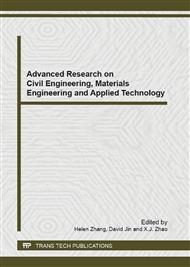p.70
p.76
p.80
p.87
p.91
p.95
p.100
p.105
p.109
Finite Element Analysis of the Subsidence of Cap Rocks during Underground Coal Gasification Process
Abstract:
This paper discusses the possible surface subsidence and deformation of the overlying rock during the underground coal gasification (UCG) process, which is an important part of feasibility studies for UCG operations. First coal seam roof movement and surface subsidence in the shallow UCG process were simulated by a finite element model coupled with heat transfer module in COMSOL. Numerical results from this model were compared with and in good agreement to the existing studies. This was followed by the development of model for deeper coal seam cases. The comparison of the numerical results from two models shows that surface uneven settlement in deep underground coal gasification is only 7% of that in shallow underground coal gasification.
Info:
Periodical:
Pages:
91-94
Citation:
Online since:
December 2013
Authors:
Price:
Сopyright:
© 2014 Trans Tech Publications Ltd. All Rights Reserved
Share:
Citation:


